The Venice Biennale – Small Countries on the Extremes
Venice isn’t far away from Vogue in the days when the Biennale comes around. The hype is, to use a hyped word, intense. You can visit the French pavilion and see another group of works by Ai Weiwei. More by the Chinese artist is on the Giudecca, just across a channel south of Venice. You can visit the German Pavilion, serving this time as the French Pavilion, and see three videos of a piano performance (one of them a mixing of a remix) by Anri Sala, a Chanel model of an Albanian who is representing France this year. It probably doesn’t hurt that Sala is the Mel Gibson of the art world at the Biennale – not in religious fervor, but in his rugged look. Featured image: Palestinian “settlement” created by visitors.
Anri Sala and Maribel VerduBut strip away the contemporary glamour from Venice, and you have a city of extraordinary art and architecture, much of which can be viewed in serenity, even when the thickest crowds are swarming to the Arsenal and the Giardini on the east end of town. Venice has always been that way, calm when off the tourist trail. You also have centuries of an economy supported by trade, important to note for everyone who says that the place has become too commercial, which it has. And you have the plague, which almost wiped Venice out in the 15th century. Next time you smell the sea at low tide, remember that it could be far worse.
Plague doesn’t get you jewelry sponsors, not right now. There weren’t many works of art referring to HIV-AIDS this year. But at the improbable Macedonian Pavilion – the most surprising work was at the far-flung pavilions of smaller countries – the references seemed to be there.
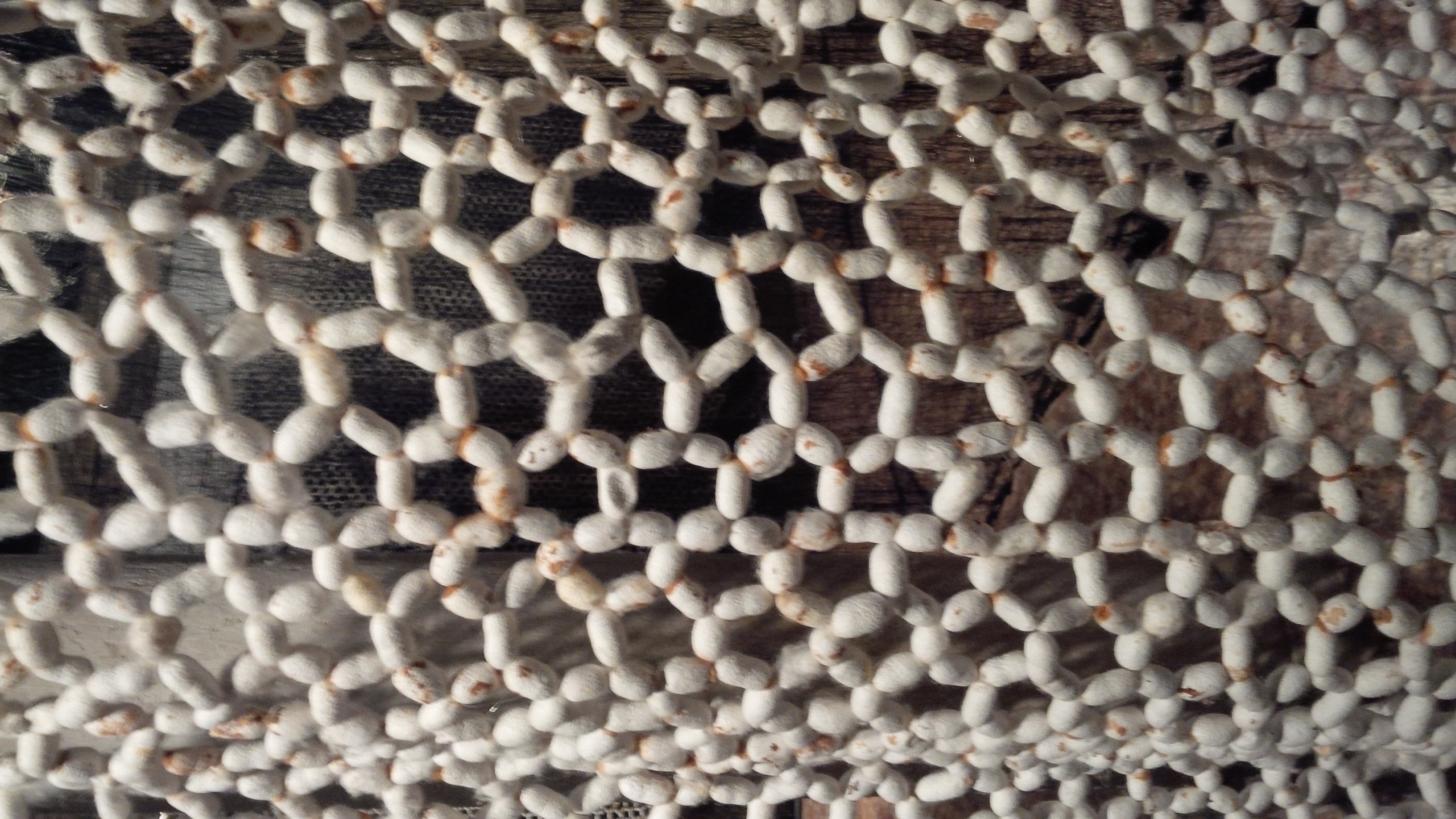
Chains of Silk Worm larvae at the Macedonian Pavilion
The installation created by Elpida Hadzi-Vasileva, who divides her time between the UK and Macedonia, is a maze. Half the walls are interlaced dead albino rats, and half are strands of silk and the eggs of silk worm larvae. At the Biennale where more than half the works on view are video, i.,e., moving pictures, there are also some moving components at this site. Live rats in a cage are there, also. I was warned not to use flash photography, so as not to frighten them. This version of the Silk Road is called Silentio-Pathologia.
The pavilion is a short walk from another plague-related site, the Scuola Grande di San Rocco, a hall attached to the Church of the same name. San Rocco is the patron saint of the plague and of all diseases. Legend says that he was from a French noble family, and that he contracted plague in the late 14th century on a pilgrimage to Rome. Rocco survived the plague and returned to Venice, it is said, in the company of a dog licking his wounds, which are always depicted on his legs. His body is said to be preserved in the church. Tintoretto painted the walls, ceiling, and the Sala dell’Albergo, where his famous Crucifixion is. Elpida Hadzi-Vasilaeva, who speaks English with what sounds like a Macedonian-inflected East End accent, hadn’t heard of San Rocco, or of Tintoretto’s tour de force. She seems to have found enough inspiration in the silk. The larvae have an odd odor, not unpleasant, but like the soft gentle mold. “Odor is very important in my work,” she said. How fitting for Venice. Another note: the live rats have been placed in homes as pets once the Biennale ends. If you’re thinking of acquiring one, they are about 60 euros in a local pet store.

‘Welcome to Iraq” by Abdul Raheem Yassir — Informing the World, One Tote Bag at a Time
Nearby, in the Ca’ Dandolo, a palazzo on the Grand Canal, is the Iraqi Pavilion, Welcome to Iraq, a collection of works by artists living in Iraq. A previous Iraqi Pavilion showed works by ex-pat artists, who worked free of the constraints of being an artist in Iraq; but in Iraq itself, artists live in what cynics might call the Piaga Americana, the American Plague. A cartoon by Abdul Raheem Yassir on a tote bag, — the best and most durable handed out by any pavilion in Venice, and there were dozens — set the tone. “Welcome to Iraq,” it read, and the picture showed a man with a gun, being held up by police. The suggestion could be that no one is innocent. Mission accomplished.
Among the other objects on view were furniture assembled from found objects – war trash and the ruins of destroyed homes – and whimsical constructions of cardboard, including an entire room made of that material, a play on the rebuilding that the American government assured the world would happen gloriously. The dominant structure that seems to have emerged from the ruins successfully is the US Embassy, the largest in the world.
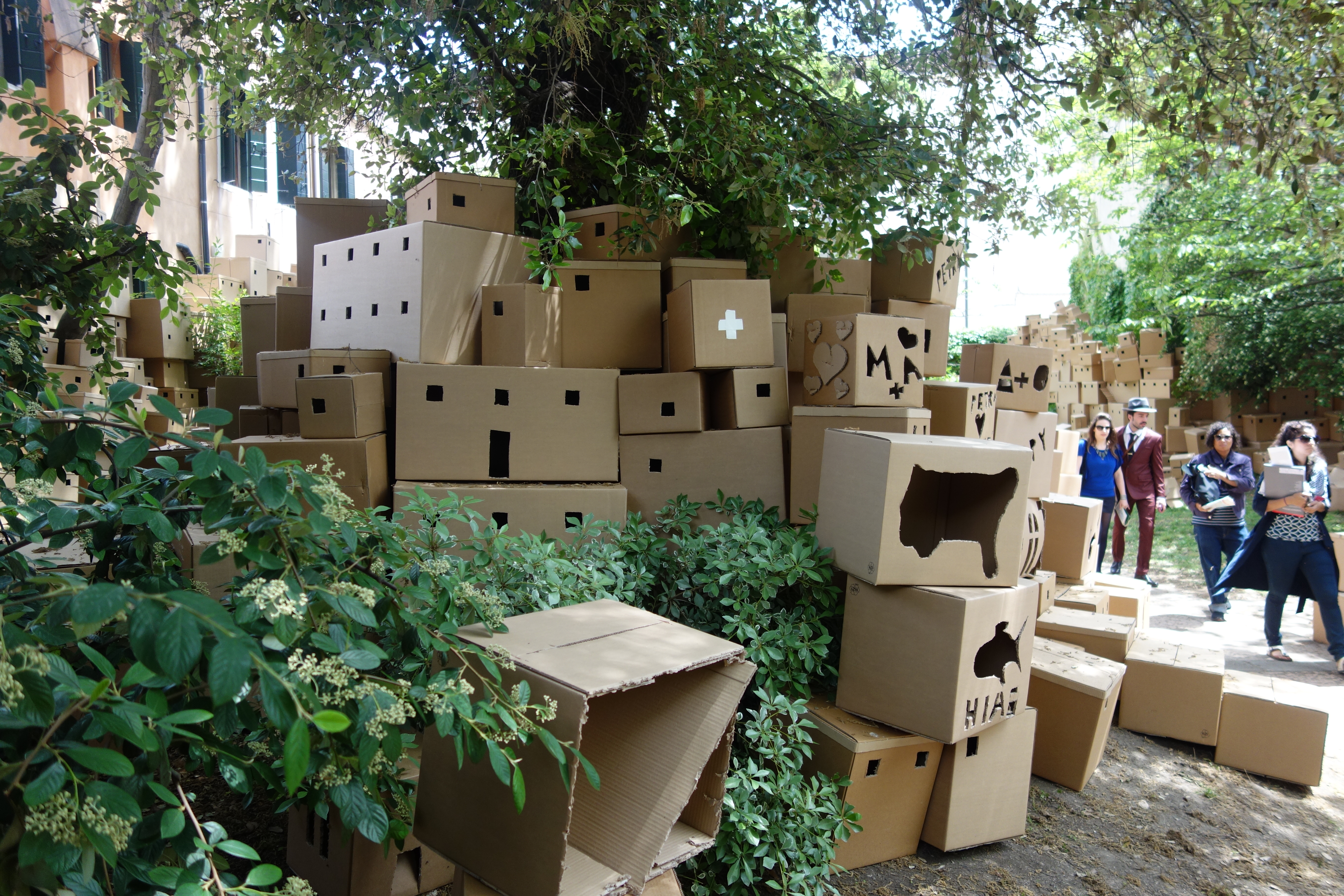
Palestinian “Settlement” Created by Visitors
On the way from Ca’ Dandolo to the Accademia Bridge, one of the most heavily traveled paths in the city, visitors tend to happen by the Palestinian exhibition, not a bona fide pavilion, since Palestine is not recognized by the Venice Biennale as a sovereign state. The Palestinians do not have a publicist, hence the low profile among so much well-funded hype. I was among the many who found it by accident. On the ground floor of an art school is the exhibition Otherwise Occupied, most of which is piled into the garden outside. Pile is the word, since visitors take boxes, and decorate them, and then stack them in “settlements” outside.
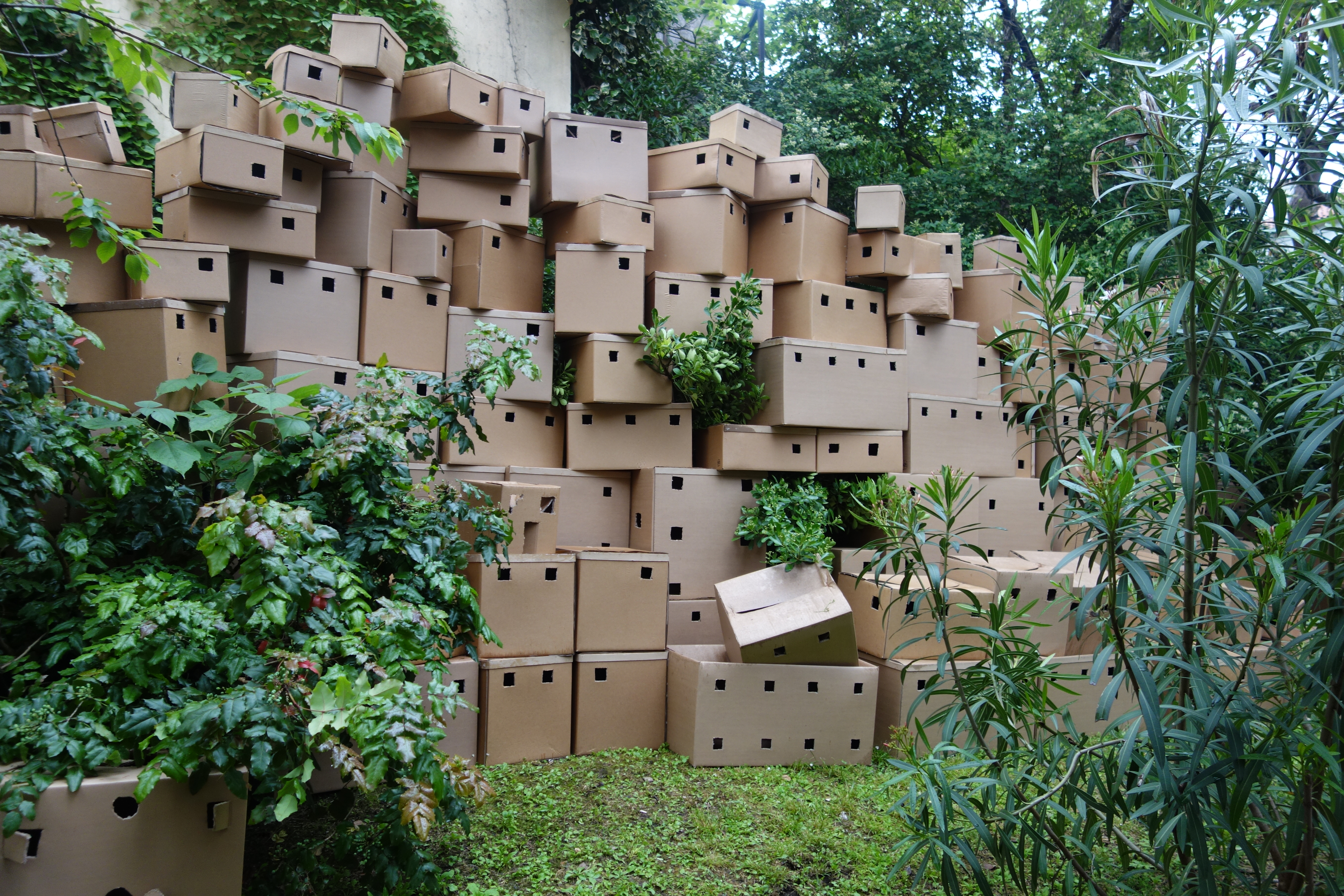 The garden grew into clusters of settlements overnight, ensembles with their own topography and decorative styles – from Arabesque motifs to the names of the persons who left the boxes there, also with “end apartheid now” and other slogans, some written in Hebrew. Sentiment was overwhelmingly pro-Palestinian, despite the show’s second-class status as a satellite exhibition. With all the talk of popular art, here was something that came close to a democratic act, also reproducing the congested feel of contested territory.
The garden grew into clusters of settlements overnight, ensembles with their own topography and decorative styles – from Arabesque motifs to the names of the persons who left the boxes there, also with “end apartheid now” and other slogans, some written in Hebrew. Sentiment was overwhelmingly pro-Palestinian, despite the show’s second-class status as a satellite exhibition. With all the talk of popular art, here was something that came close to a democratic act, also reproducing the congested feel of contested territory.
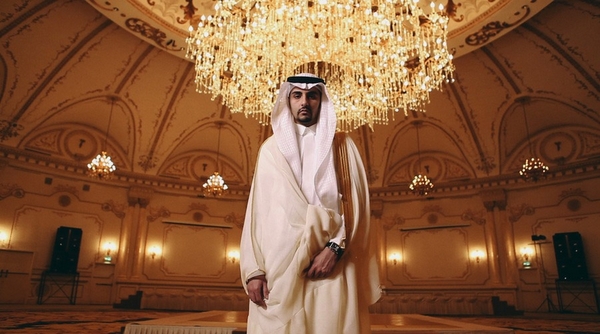
Enter the Saudi YouTube Generation
On the south side of the Dorsoduro neighborhood, facing the Giudecca, an island that runs across from the southern rim of Venice, was the Saudi exhibition called Rhizoma, Generation in Waiting, organized by the Edge of Arabia group, an arts organization active in a land from which not much is expected in contemporary art. A camel daubed in spray paint on a panel at the door suggested otherwise. It was the work of Omama Al Sadiq, who appeared, covered pursuant to Saudi custom, but also wearing a camouflaged army jacket with spikes on the shoulders. I asked the young woman, in her early twenties, how she got through Customs with the jacket. She shrugged, and smiled, and explained in perfect English that it hadn’t been a problem. Given Saudi strictures, you could see why the show’s curator, an Iranian living in London named Sara Rasa, might not have wanted official status for a show that she said exhibited the Saudi “YouTube generation”. Ceci n’est pas un pavillon.
Saudi satire sounds like a contradiction in terms, but the group show had a lenticular photograph of Mecca, the holy city; it was as traditional a city view as a reverent postcard when seen from one side, and grotesque in the cluster of high-rise buildings surrounding sacred places when seen from the other. Some of the most satirical works were by women — pictures showing female figures, covered head to toe, inserted into paintings by Degas, or comic videos of women tearing a room apart.
Rhizoma was so unofficial that Prosecco was served at its opening, although Saudi women at the show were fully covered, an atypical sight in the heat and fashion parade of the Biennale.
Ireland, once the Saudi Arabia of the Atlantic under the thumb of the Catholic Church, is looking outward in its pavilion, located near the church of San Samuele. The subject of The Enclave, a work by Richard Mosse, is the brutal ongoing war in the Congo.
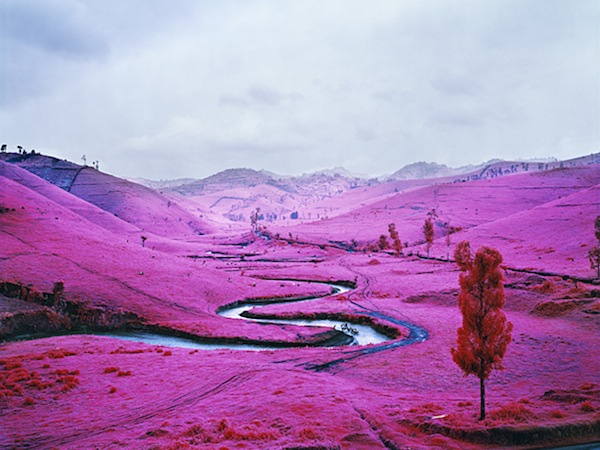
Beyond Fauvism – Richard Mosse, The Enclave
Moss, a photographer, is working in video here, with a tonal filter that changes green to tremulous red, a fitting color for a landscape where millions have died. This isn’t photo-journalism – Mosse’s photography isn’t trying to replicate events with a literal specificity – it’s a slow tour of otherwise breathtaking landscapes. We don’t witness massacres, but we feel at least part of their effect, a chilling sense of dread. These killing fields have a lyricism all their own in crimson. Flowers of evil once again.
Mosse’s elegant work was some of the best-received in Venice, which may be faint praise given the silliness of so much on view at the much-visited sites. Yet the landscape and the sense of a radiant land of walking dead was already put on film, and similarly stylized, in War Witch, which won the top prize at the Berlin International Film Festival two years ago. It’s odd, in a Biennale where more than half the work is moving pictures, that the audience seemed unaware of what had already had an impact in the world of cinema. Ah, the insularity of those who assume that they see things globally.
More to come from the outskirts of the Biennale …..
